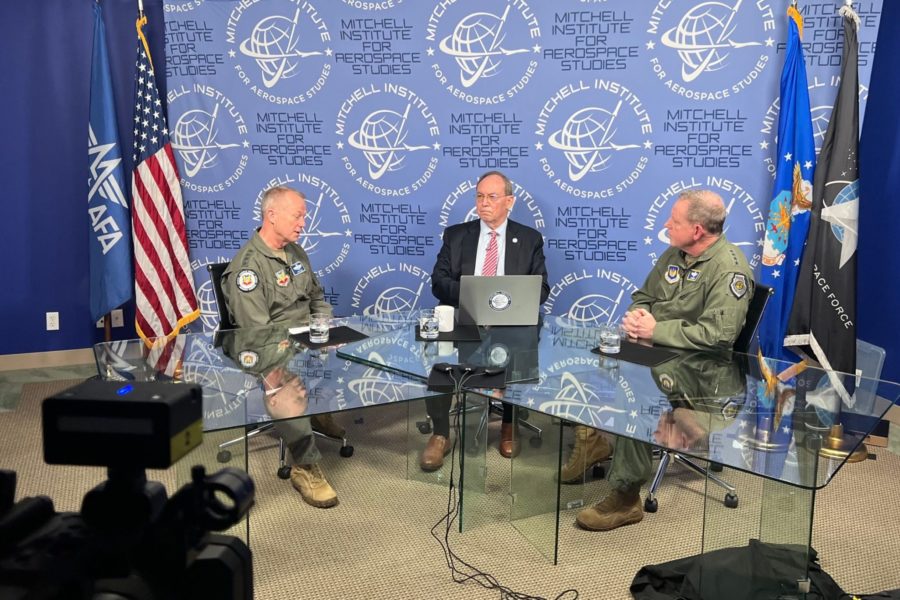Russia’s invasion of Ukraine has proven that air superiority is vital to success in conflict, Gen. James B. Hecker, the top U.S. Air Force commander in Europe, said March 22.
“One of the things that we see is the lack of either side, whether it be the Russian or Ukrainians, the ability to get air superiority, has really changed this into a different fight that we haven’t seen in quite a while,” Hecker said during an event held by AFA’s Mitchell Institute for Aerospace Studies.
Hecker laid out a sobering argument: if Russia had gained air superiority early in the conflict, Ukraine would have been finished off militarily long ago.
Instead, Russia was stymied by Ukraine’s air defenses and its own poor tactics, buying valuable time for Ukraine to gather international support. Since 2022, the U.S. has pledged over $40 billion to Ukraine. Air Force Gen. Jacqueline Van Ovost, the head of U.S. Transportation Command, said recently there had been 1,000 airlift sorties and an additional 65 shiploads of aid sent to neighboring countries, which then entered Ukraine via its land borders. Regardless of the will of Ukraine’s allies, the West would not have been able to come to Ukraine’s aid in that way if Russia had control of the skies, Hecker said.
“Let’s say the Russians had air superiority,” he said. “If they were able to, all the equipment … wouldn’t have gotten there because there would have been Russian close air support sitting over those lines of communication coming in from the other countries, and as soon as it got into Ukraine, it would have been demolished.”
Conversely, Ukraine has struggled to put its small air force up against Russian air defenses. Hecker said a more powerful air force on the Ukrainian side could have blunted Russia’s invasion in its initial phases.
Instead, a brutal conflict has slogged on for over a year. Both sides have suffered tens of thousands of casualties in the battle now taking place with 155mm howitzers and HIMARS rockets, two systems that the U.S. has been able to send over the border into Ukraine. Russia has resorted to Iranian-provided one-way attack drones and stand-off cruise missiles to pummel Ukraine from the air.
“At least from the Russian side, they don’t care if you hit hospitals, they don’t care if you hit schools, they don’t care if you hit malls,” Hecker said. “Massive destruction, massive casualties—just something that we’re not used to.”
Hecker’s determination about the importance of airpower carriers broad implications, given his position as commander of both U.S. Air Forces in Europe (USAFE) and NATO Allied Air Command—making him the airpower point person for 30 countries. Since the conflict began, NATO has expanded from air policing missions, in which fighters fly combat air patrols, to exercises that approximate what NATO would do if Russia expanded its war to the West, triggering Article V, the alliance’s mutual self-defense clause.
“What we’re looking at and concentrating on at USAFE is what can we do to ensure that we get air superiority should we have to invoke Article V, and then what can we do to make sure that our enemy doesn’t get air superiority,” Hecker said.
Hecker’s focus is on ensuring that NATO can quickly suppress enemy integrated air defense systems (IADS).
“The number one priority to make sure that we’re able to get air superiority is to make sure that we can do the counter-IADS mission,” Hecker said. “What we’ve seen on both sides, both Russia and Ukraine, is their integrated air and missile defense is working pretty well, to the point where they’re shooting down the other’s aircraft and the aircraft aren’t as visible as they should if they’d concentrated more on air superiority.”
Ukraine has lost around 60 aircraft and Russia has lost over 70 aircraft, Hecker revealed at the AFA Warfare Symposium in early March.
NATO, in turn, must bolster its own air defenses, Hecker said. The Air Force must also increase information sharing among allies and focus on Agile Combat Employment (ACE) to disperse its targets, he said.
In Hecker’s role as commander of USAFE, he is helping the U.S. provide Ukraine with information to assist its targeting. The U.S. has also been providing hardware, including AGM-88 HARM anti-radiation missiles to attack Russian surface-to-air missile sites, and 500-pound JDAM extended-range guided bombs.
America has declined to provide long-range ATACMS missiles for HIMARS and has prohibited U.S.-origin weapons from being used against Russian territory. Ukraine’s air force will also be aided by the donation of 17 Soviet-era MiG-29s from eastern European NATO allies. But Russia’s air defense is largely located in Belarus and Russia, posing an additional challenge for the MiGs, Hecker said.
“Any more quantity is going to help,” Hecker said. “This will allow them to come at different axes, which will complicate the problem Russia has.”
There is one aspect of the war that Hecker thinks must remain the same.
“In the short term, we just need to make sure that Russia does not get air superiority,” he said.
